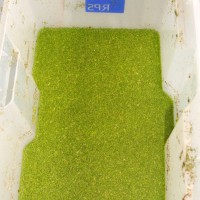
Least Duckweed - Lemna minuta
Expand and collapse the sections below by clicking on the title or + / - icons.
Short description of Lemna minuta, Least Duckweed
Least duckweed is small and distinguished from other species by the single root, single vein and the relatively lengths of the nerve and air cells to the length of the frond. It is translucent and most easily recognised by its colour.
Impact summary: Lemna minuta, Least Duckweed
The actual impact of least duckweed is difficult to assess; it probably has little effect on natural habitats and has not had health, social or economic impacts because it behaves in the same way as native duckweeds.
Habitat summary: Lemna minuta, Least Duckweed
As with other duckweed species, least duckweed typically occurs in standing water, slow-flowing water courses such as canals and rivers and in backwaters of rivers and streams.
Overview table
| Environment | Freshwater |
|---|---|
| Species status | Non-Native |
| Native range | Canada Temperate, Western half United States, Eastern United States |
| Functional type | Land plant |
| Status in England | Non-Native |
| Status in Scotland | Non-Native |
| Status in Wales | Non-Native |
| Location of first record | v.c.29 (Cambridge) |
| Date of first record | 1977 |
Origin
Least duckweed is a native of temperate North and South America. In Europe it was recorded in France in 1965, Germany in 1966 and Switzerland in 1973.
First Record
Least duckweed was first recorded in GB in Cambridge in 1977
Pathway and Method
It is likely that introduction to GB was accidental, probably when least duckweed occurred as a contaminant with aquatic plants imported for horticulture. Once it had arrived in an outdoor pond, it is likely to have been transported to other natural sites on clothing, equipment or possibly by animals.
Species Status
Least duckweed has been introduced to Japan, as well as becoming established throughout much of Europe, including Belgium, France, Germany, Hungary, Poland, Portugal, Spain, Switzerland and the Ukraine. In GB, it spread rapidly, increasing from ten 10 km squares in 1986 to 170 in 1995, more than 500 by 2000 and more than 700 in 2010.
Dispersal Mechanisms
It is likely that plants are transported between sites on boats, machinery used to maintain water bodies, on fishing equipment and even on clothing. It is also possible that animals transport plants between sites.
Reproduction
Least duckweed has been found flowering and setting seed in the south-west of France, but not to-date in GB. All reproduction must therefore be vegetative and is through the development of additional fronds which eventually separate from the parent plant to form a new plant.
Known Predators/Herbivores
None known.
Resistant Stages
None known.
Habitat Occupied in GB
As with other duckweed species, least duckweed typically occurs in standing water, slow-flowing water courses such as canals and rivers and in backwaters of rivers and streams.
Least duckweed is well established much of southern England, particularly south of a line from the Severn Estuary to the Wash. There are scattered populations in Wales, northern England, southern Scotland and Ireland. Identification is still poorly understood and it is likely that more accurate recording would give a different picture.
Environmental Impact
None known.
Health and Social Impact
None known.
Economic Impact
None known.
Identification
Stace, C.A. (2010) New flora of the British Isles, Third Edition, Cambridge University Press, Cambridge.
Lansdown, R.V. (2009) A field guide to the riverine plants of Britain and Ireland. Ardeola, Stroud, Gloucestershire.
Biology, ecology, spread, vectors
Muller, S. (2004) Plantes invasives en France: État des connaissances et propositions d’actions. Museum National d’Histoire Naturel, Paris.
Management and impact
Muller, S. (2004) Plantes invasives en France: État des connaissances et propositions d’actions. Museum National d’Histoire Naturel, Paris.
General
Landolt, E. (1986) Biosystematic investigations in the family of duckweeds (Lemnaceae), 2. The family of Lemnaceae – a monographic study. Volume 1. Veröffentlichungen des Geobotanschen Instituts der Eidg. Techn. Hochschule, Stiftung Rübel, in Zürich 71.
Spotted this species?
Distribution map
View the Distribution map for Least Duckweed, Lemna minuta from BSBI

Native range map
View an interactive native range map for Least Duckweed, Lemna minuta

